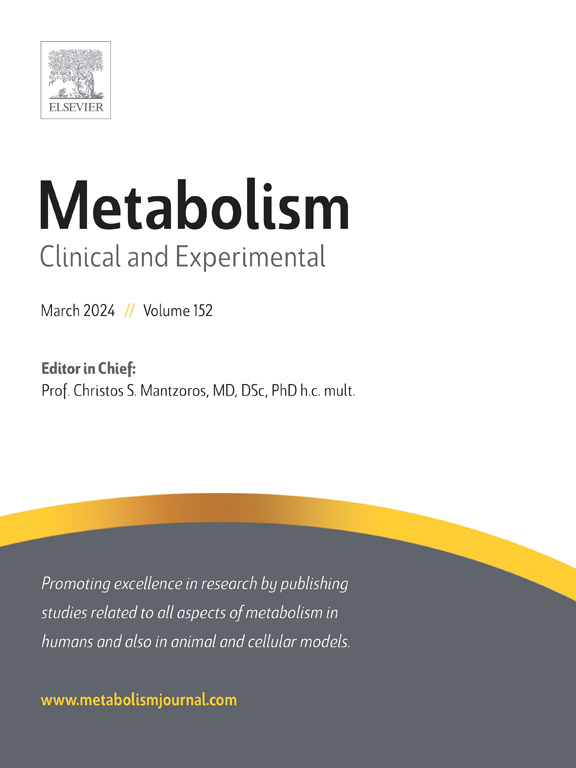肝脏CB1受体信号在瘦小鼠中触发Gi/oα介导的脂肪分解,而在肥胖小鼠中触发gs α介导的脂肪生成。
IF 11.9
1区 医学
Q1 ENDOCRINOLOGY & METABOLISM
引用次数: 0
摘要
肥胖诱导的脂肪变性肝病(SLD)是由脂肪细胞衍生的脂肪酸(FAs)通过FA转位酶CD36摄取到肝细胞驱动的,这也通过抑制AMP激酶(AMPK)介导的FA氧化(FAO)来阻止它们的消耗。我们探讨了肝细胞CB1受体(hCB1R)通过调节CD36及其下游靶点来控制肝脏甘油三酯(TG)含量的作用。方法:采用hCB1R基因敲除(hCB1Rko)小鼠和对照组小鼠,分别饲喂标准和高脂饮食,分析hCB1R基因介导的肝脏基因表达谱和培养肝细胞的脂质代谢。结果:多组学数据表明,hCB1R靶向一组与SLD相关的基因,包括Cd36。在饮食性肥胖小鼠中,hCB1R信号通过CD36-AMPK-FAO通路参与SLD的发生,并通过CB1R阻断逆转SLD。但是,在瘦小鼠中,hCB1R信号抑制CD36表达并激活ampk介导的FAO。这些相反的作用在有或没有油酸(OA)孵育的AML12小鼠肝细胞中被复制。GPR3的内源性配体OA诱导hCB1R信号从Gi/oα介导的cAMP减少转变为GPR3/Gsα依赖的方式,通过增加脂肪变性肝脏中Gsα:Gi/oα蛋白的比例来促进cAMP的增加。结论:在瘦状态下,内源性大麻素激活hCB1R会增加FAO,从而减轻SLD,正如慢性大麻吸烟者所报道的那样,而在肥胖小鼠中,hCB1R会抑制FAO,从而促进SLD,这是外周CB1R阻断抗脂肪变性作用的基础。本文章由计算机程序翻译,如有差异,请以英文原文为准。

Hepatic CB1 receptor signaling triggers Gi/oα-mediated lipolysis in lean mice but Gsα-mediated lipogenesis in obese mice
Objectives
Obesity-induced steatotic liver disease (SLD) is driven by the uptake of adipocyte-derived fatty acids (FAs) into hepatocytes via the FA translocase CD36, which also prevents their consumption by inhibiting AMP kinase (AMPK)-mediated FA oxidation (FAO). We explored the role of hepatocyte CB1 receptors (hCB1R) in controlling hepatic triglyceride (TG) content by regulating CD36 and its downstream targets.
Methods
hCB1R knockout (hCB1Rko) mice and their control littermates kept on standard or high-fat diet were used to analyze hCB1R-mediated hepatic gene expression profile and lipid metabolism in intact mice and in cultured hepatocytes.
Results
Multi-omics data indicate that hCB1R target a distinct set of genes associated with SLD, including Cd36. In mice with diet-induced obesity, hCB1R signaling via CD36-AMPK-FAO pathway contributes to both the development of SLD and its reversal by CB1R blockade. But, in lean mice hCB1R signaling inhibits CD36 expression and activates AMPK-mediated FAO. These opposite effects were replicated in AML12 mouse hepatocytes incubated with or without oleic acid (OA). OA, an endogenous ligand of GPR3, induced a switch in hCB1R signaling from a Gi/oα-mediated reduction in cAMP to a Gsα-mediated increase in cAMP in a GPR3/Gsα -dependent manner, facilitated by increasing the ratio of Gsα:Gi/oα proteins in the steatotic compared to lean liver.
Conclusions
In the lean state, endocannabinoid activation of hCB1R increases FAO, which mitigates SLD, as reported for chronic marihuana smokers, whereas in obese mice hCB1R tonically inhibit FAO, which promotes SLD and underlies the anti-steatotic effect of peripheral CB1R blockade.
求助全文
通过发布文献求助,成功后即可免费获取论文全文。
去求助
来源期刊

Metabolism: clinical and experimental
医学-内分泌学与代谢
CiteScore
18.90
自引率
3.10%
发文量
310
审稿时长
16 days
期刊介绍:
Metabolism upholds research excellence by disseminating high-quality original research, reviews, editorials, and commentaries covering all facets of human metabolism.
Consideration for publication in Metabolism extends to studies in humans, animal, and cellular models, with a particular emphasis on work demonstrating strong translational potential.
The journal addresses a range of topics, including:
- Energy Expenditure and Obesity
- Metabolic Syndrome, Prediabetes, and Diabetes
- Nutrition, Exercise, and the Environment
- Genetics and Genomics, Proteomics, and Metabolomics
- Carbohydrate, Lipid, and Protein Metabolism
- Endocrinology and Hypertension
- Mineral and Bone Metabolism
- Cardiovascular Diseases and Malignancies
- Inflammation in metabolism and immunometabolism
 求助内容:
求助内容: 应助结果提醒方式:
应助结果提醒方式:


